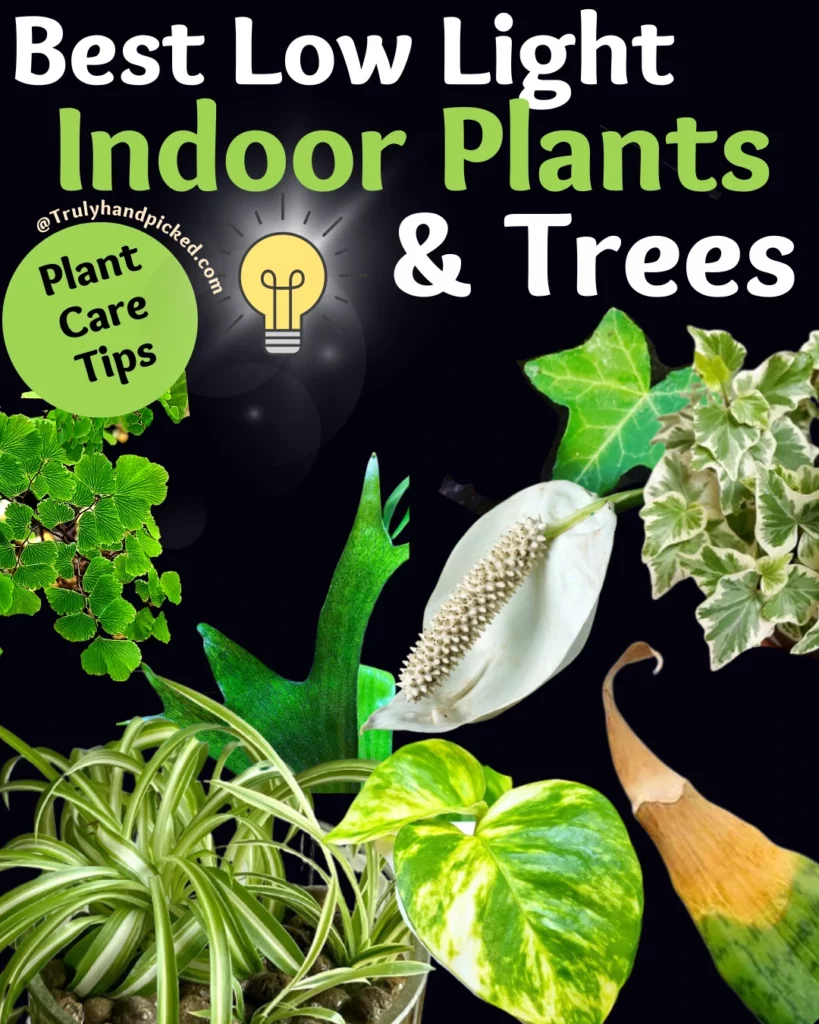Plants and trees, which thrive greatly in low light are like blessings for indoor gardeners. If your favorite plants can beautifully grow with fertilizer and water with a little bit of light, what else does an indoor gardener wish for?
However, you must recognize which plants do well in low-light climates first. Here is a simple guideline highlighting those types of indoor trees and houseplants with some maintenance tips as well. Let’s check them out below-
9 Best Indoor Plants That Grow in Medium to Low Lighting:
Spider plant is one of the easy-to-grow houseplants around. It requires only 4-5 hours of indirect sunlight a day to thrive properly.
You need to provide partial shady sunlight with a heavy amount of water to keep the spider-offshoots-like leaves of this plant green consistently.
Can survive without much natural light. Thrives with little sunlight and indoor lighting.
Golden Pothos:
Golden Pothos is a houseplant that can grow even in no-light conditions for someday. You can provide a shady or low-light place for giving this plant a proper thriving climate.
Related: Pothos complete plant care
Those deep green heart-shaped leaves of Golden Pothos require only partial or full shade in the daytime to maintain their variegated foliage perfectly.
Can pothos handle dark rooms? Not pitch dark room, but makes a good hanging plant even in corners with low indirect light
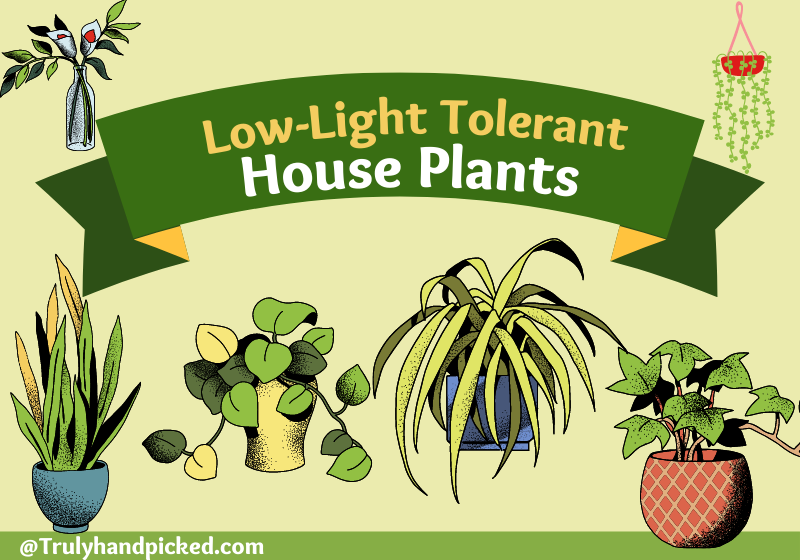
Lucky Bamboo:
Lucky bamboo houseplants need full shade of sunlight to grow properly. They can tolerate a temperature between 65 to 95 degrees F to grow healthily. Tropical condition with a hardiness zone of 10-11 is considerable for such plants.
This classy-looking indoor bamboo plant brings luck and fortune while kept in your house. Try to provide them with at least 6 hours of indirect sunlight a day to fulfill the required heat.
Without bright indirect light, bamboo won’t grow faster and lusher. Yet it can handle a low light spot on your desk or office room table.
Staghorn Fern:
Staghorn fern is one type of air plant or epiphytic. So, they can grow easily on other plants and thus, don’t requires many elements to thrive. Full shade light and a moderate amount of moisture are enough to maintain this houseplant.
Try to provide 4-7 hours of shady sunlight to your staghorn fern plant in a location with high humidity.
These beautiful foliage plants can survive low light and yes they are happy in a shady bathroom too. Provided at least little light falls in the bathroom every day.
Related: Best bathroom plants that tolerate moisture and low light
English Ivy:
Despite being a bright-light plant, English ivy houseplants can stand medium to low light to grow properly. Thus, you can grow this plant in low light conditions, but, it thrives best under subtle yet indirect sunlight.
You have to provide 6-8 hours of indirect light to an English ivy plant to keep its green curvy foliage in perfect condition.
English ivy is a fast-growing ground cover that may need bright indirect light but, it can easily tolerate a shady spot in your room too.
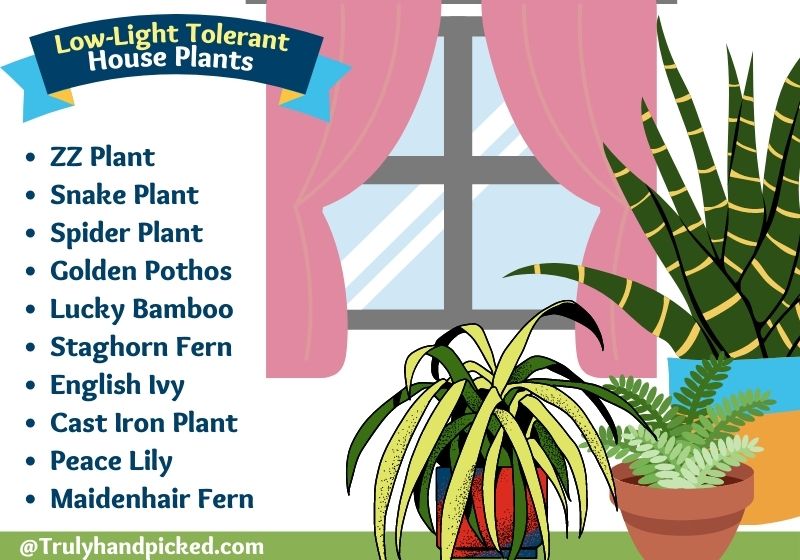
Cast Iron Plant:
A cast-iron plant can’t stand direct sunlight and thus can thrive indoors easily in low light. You can place them outside at the beginning stage but, try to keep them in an outdoor perennial.
Once the plant reaches a moderate height, bring it inside your room and keep it in a spot where it can get 4-6 hours of shade or partial sunlight. This plant can grow 2 feet long and live many years if get a proper climate consistently.
As already said better than bright light, cast iron plants can survive in a medium to a low-light room even away from your sun-facing window.
Peace Lily:
Peace lily plants are tropical and thus doesn’t like cool or dark condition. But they can grow easily in partial or full shade spots of your house. Thus, you can grow this beautiful plant as a low-light houseplant easily.
Peace lily can tolerate underwater consistency and low light to grow healthily. So, you can put it in any room of your house happily.
Maidenhair fern typically grows under partial or full shade areas. So, you can maintain them easily in an indoor garden area. They can’t tolerate dry soil for long, so, never put this species of fern under direct sunlight and keep them watering every few whiles.
Well-drained fully fertilized soil with organic matter is the best choice to plant maidenhair fern under a low-light climate.
Snake plants can stand various lighting climates and thus, can grow indoors with low light conditions. However, you must provide snake plants with at least 5-6 hours of direct or partial shade light every day.
Try to keep the planter of your snake plant 10 feet away from your window. A south or west-facing window is the best place to let this plant thrive well with its snaky green attractive leaves.
This slow-growing hardy plant is the best in handling harsh sun and low light eventually. Surviving in dark is not easy for all plants. Snake plants won’t demand a bright light every day, but forgives you for placing them in a low-light spot.
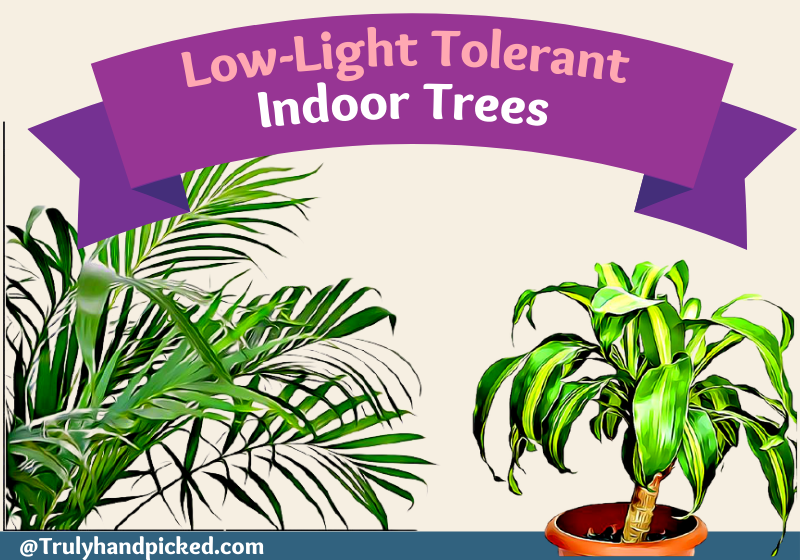
9 Best Indoor Trees for Medium to Low Light Rooms:
Areca palm (Dypsis lutescens) is one of the best palm species to grow in an indoor area. They are extremely easy to maintain in the in-house climate and require only 4-5 hours of indirect sunlight to thrive.
This indoor palm tree category can grow 6-8feet long in an indoor planter and can provide an amazing air-purification quality to the room it places.
Areaca plams are non-toxic, safe for pets, and add beauty to your bedroom. More than a Feng shi plant it produces more oxygen and is easy to take care of even in low light.
Soil: Sandy loam and slightly acidic.
Best for south windows but can also thrive in east and north windows.
Lady Palm:
This palm tree (Rahpis) species can thrive supremely healthy in low-light indoor conditions. They need a full or partial shade of sunlight to grow perfectly.
You need to put them near your east-facing window to provide the adequate sunlight they need. This way your palm tree will get the subtleness of the morning sun but not the scorching hit of noon.
Grows well in rich organic matter and well-drained moist soil. Having said moist doesn’t mean too much water and a soggy medium, as it can end in roots rot and show browning leaving tips. Full sun hours and direct exposure could burn the plant’s leaves.
Soil: Loamy soil and pH from acidic to neutral.
Window facing: Indirect light from south or west or direct morning sunlight at the east window.
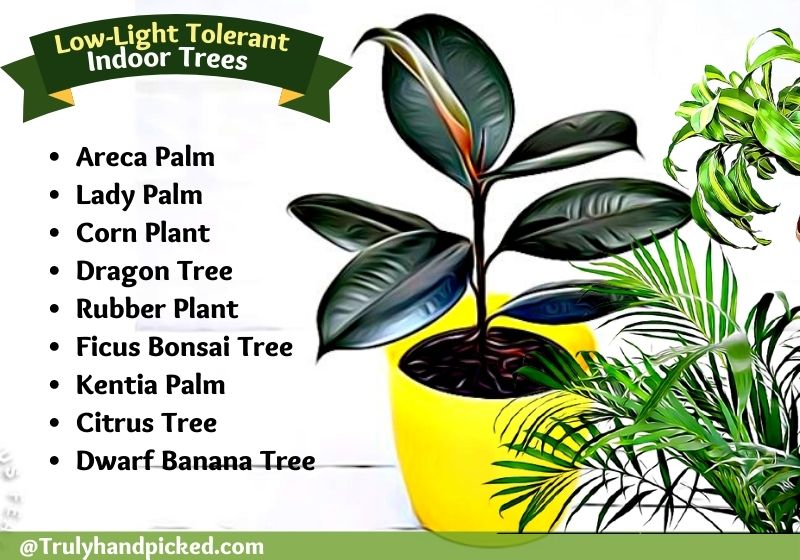
Corn Plant:
Corn plants (Dracaena fragrans) can tolerate full to low sunlight and thrive best by consuming 65-70 degrees of F during their entire growing session. The dracaena corn species performs most comfortably while getting indirect or filtered sunlight instead of direct heat.
Try to put them near the north or west-facing window to provide the best climate for their initial growth. Remember that if you keep your indoor corn tree put in direct sunlight for a long, it may scorch leaves and have a hampered cropping experience too.
Soil: Slightly acidic and loamy soil.
Window Direction: Requires less maintenance and do well in low lighting condition near an east window. But bright indirect light from the south is good for growth and glossy green leaves. Direct light from the south can scorch its leaves.
Dragon Tree:
Dragon plant (Dracaena marginata) is an indoor tree that needs 4-6 hours of sunlight to thrive but that must be filtered. This species is called the Madagascar Dragon tree and can grow 3-4 feet long in a small planter.
Try to provide indirect low light to this plant to keep its leaves healthy and green adequately. You can put this plant anywhere in your house or office area, as it never requires direct light to grow.
Window: North and east windows are preferable, as dragon trees won’t tolerate bright and direct light. In the latter case, you can use a sheer curtain to filter the harsh sunlight.
Soil: Loamy soil with a neutral to acidic pH range. A mix of perlite, compost, soil, and peat moss is fine
Rubber plants (Ficus elastica) are one of those indoor trees that require a very -low amount of light to thrive properly. You have to protect your rubber tree from direct sun heat and provide filtered light all the time.
Try to put your rubber tree in a north-facing window for low-maintenance purposes. Hanging a sheer curtain on that window would be better to provide the rubber tree with even more secure light.
Soil: Well-draining, aerated moist acidic soil. (Organic matter+soil+perlite/cocopeat/peat moss). Too much or less watering can make your house plant leaves curl. Fertilize once a month if stunted growth is seen.
Window Direction: Bright spots with indirect sunlight for hours together will help the plant to happily thrive indoors.
Ficus Bonsai Tree:
The Ficus bonsai tree or Fig tree is another low-light indoor tree that requires almost 6 hours of indirect sunlight through a window. It can grow 5-9 feet in a small indoor planter.
So, you can easily grow this species of fig tree in your indoor garden area. The only requirement of Ficus bonsai is an adequate amount of water supply, along with a moderate amount of sunlight.
Soil: Fiscus bonsai likes well-draining succulent/cactus soil mixed with the rich matter to support its growth.
Window facing: Avoid dark and full shade, go for south windows with few hours of direct sunlight. While east and west-facing windows are acceptable too.
Kentia Palm:
Kentia palm (Howea forsteriana) tree can tolerate only 20-25 degrees of F during its growing session. So, try to put your tree in a shady place where it can get 4-5 hours of indirect sunlight in a day.
A north-facing window could be the best place for such species of a palm trees. You can put your Kentia palm tree in an open indoor place too like a balcony or veranda, but shade the location with a canopy or cover first.
Soil: These shade-loving plants succeed in well-drained sandy-loam acidic soil.
Window: Can survive full shade and north low-light windows.
Citrus Tree:
Citrus trees need heavy water and healthy fertilizer to grow healthily along with indirect sunlight. A citrus tree mostly grows well in outdoor areas, but some of the species can thrive easily in an indoor climate.
You need to provide them with at least 7-8 hours of direct sunlight each day of their growing session to get the best planting outcome.
Soil: Indoor citrus tree prefers sandy-loamy and acidic soil. A potting mix with a mixture of organic matter, soil, and peat moss (or medium that’s good for drainage) is good.
Window: A windy south window with bright light throughout the day will help the plant to thrive and bloom. In the winter season using a grow light is recommended.
Please note they get easily stressed when the temperature turns cold outside and still we feel it bottoms the list of best low-light trees.
Dwarf Banana Tree:
This is one (Musa acuminata) of the easy-to-grow indoor plants that require a moderate amount of sunlight. Thus, you can grow this species of banana tree indoors in a low-light conditions effortlessly.
Banana trees usually need 4-6 hours of full sunlight every day to grow healthily. So, try to keep your dwarf banana tree planter at the extreme edge of your east or south-facing window.
Soil: Well-drained moist soil in a large pot to accommodate its roots, also water adequately in the summer season and repeat when the top 20% of the soil turns dry.
Though it is recommended by gardeners for its beautiful large leaves, I still feel it doesn’t fit the low-light indoor tree category.
FAQ: Indoor Plants and Trees
Why Do Few Plants Need Less Light?
Some plants have not yet evolved or adapted to face the bright and direct sun. Since they grow on forest floors or places where only dappled light reaches the plant leaves, they are used to it. So sudden changes to forced light exposure will burn or stress the plant. Just like sloths (not exactly), consume less, move less, and yet thrive happily.
Can Plants Grow Without Light or Sunlight?
Every plant can live without light or sunlight but only for a short time period. They keep their essential requirement fulfilled by the process of etiolation this time. But after a certain period, they must need sunlight or any source of light to keep their photosynthesis course continuing perfectly.
